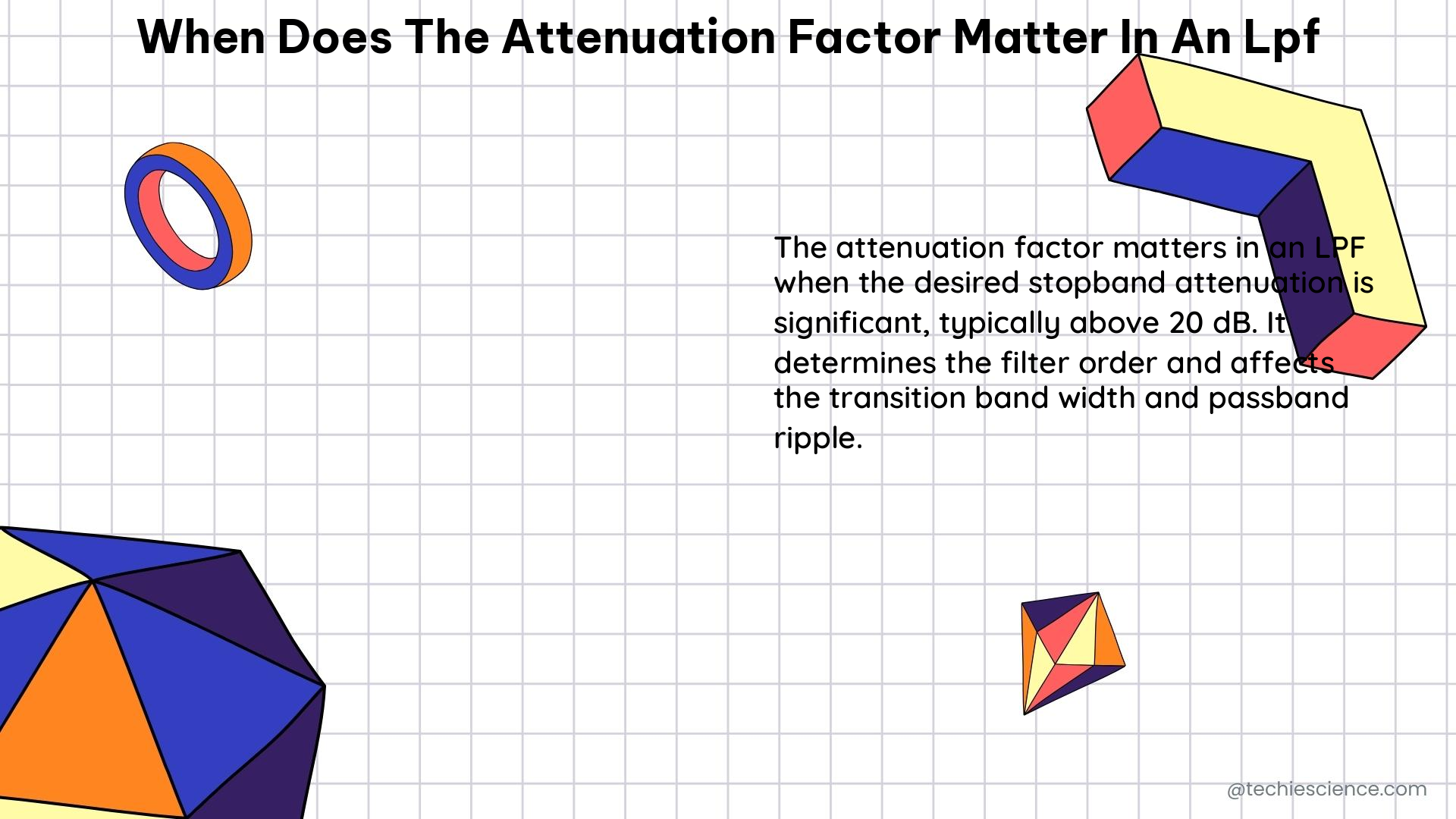The attenuation factor in a low-pass filter (LPF) is a crucial parameter that determines the rate at which the filter attenuates frequencies above the cutoff frequency. Understanding when the attenuation factor becomes significant is essential for designing effective LPFs in various applications, such as audio processing, image filtering, and signal conditioning.
Understanding the Attenuation Factor
The attenuation factor in an LPF is typically expressed in decibels (dB) and is a function of the filter order and the cutoff frequency. For example, a Butterworth filter of order 5 will attenuate all frequencies above the cutoff frequency by 20n dB/decade, where n is the filter order. This means that for every decade increase in frequency above the cutoff frequency, the filter will attenuate the signal by an additional 20n dB.
The attenuation factor is important because it determines the rate at which the filter attenuates the unwanted frequencies, which can affect the signal-to-noise ratio (SNR) of the desired signal. If the attenuation factor is too low, the filter may not effectively remove the unwanted frequencies, leading to a poor SNR. Conversely, if the attenuation factor is too high, the filter may attenuate the desired signal, also resulting in a poor SNR.
Factors Affecting the Attenuation Factor

The attenuation factor in an LPF is influenced by several factors, including:
-
Filter Order: The filter order determines the steepness of the filter’s frequency response. Higher-order filters, such as Butterworth or Chebyshev filters, have a steeper roll-off and a higher attenuation factor compared to lower-order filters.
-
Cutoff Frequency: The cutoff frequency of the LPF determines the frequency at which the filter begins to attenuate the signal. The higher the cutoff frequency, the lower the attenuation factor will be for a given frequency range.
-
Filter Type: Different filter types, such as Butterworth, Chebyshev, or Elliptic, have different attenuation characteristics. Butterworth filters have a maximally flat passband and a gradual roll-off, while Chebyshev and Elliptic filters have a sharper roll-off but may have some passband ripple.
-
Desired Signal Characteristics: The characteristics of the desired signal, such as its frequency content and amplitude, can also affect the importance of the attenuation factor. Signals with a wide frequency range or low amplitude may require a higher attenuation factor to maintain an acceptable SNR.
-
Noise Characteristics: The level and frequency content of the noise in the system can also influence the importance of the attenuation factor. If the noise is concentrated at higher frequencies, a higher attenuation factor may be necessary to effectively remove the unwanted frequencies.
When Does the Attenuation Factor Matter?
The attenuation factor in an LPF becomes significant when it starts to affect the signal strength and the SNR of the desired signal. This can happen in the following scenarios:
-
High-Frequency Noise Removal: When the desired signal is accompanied by high-frequency noise, the attenuation factor becomes crucial in effectively removing the unwanted frequencies while preserving the desired signal. In this case, a higher attenuation factor is necessary to maintain an acceptable SNR.
-
Preservation of Desired Signal Amplitude: If the desired signal has a low amplitude, the attenuation factor can become significant if it starts to reduce the amplitude of the desired signal to the point where it becomes indistinguishable from the noise. In this case, a lower attenuation factor may be required to maintain the desired signal strength.
-
Aliasing Mitigation: In digital signal processing, the attenuation factor of the anti-aliasing filter (a type of LPF) is crucial in preventing aliasing, which occurs when high-frequency components are folded back into the desired frequency band. A higher attenuation factor is necessary to effectively remove the high-frequency components and prevent aliasing.
-
Audio and Image Processing: In audio and image processing applications, the attenuation factor of the LPF can significantly impact the quality of the output signal or image. A poorly designed LPF with an insufficient attenuation factor can result in artifacts, such as ringing or blurring, which can degrade the overall quality of the processed signal or image.
-
Power Spectral Density Estimation: In signal processing, the attenuation factor of the LPF can affect the accuracy of power spectral density (PSD) estimation. If the attenuation factor is not properly considered, the estimated PSD may not accurately reflect the true frequency content of the signal, leading to incorrect conclusions about the signal’s characteristics.
To determine when the attenuation factor matters in an LPF, it is essential to consider the specific requirements of the application, the characteristics of the desired signal and noise, and the desired level of attenuation. By carefully selecting the filter order, cutoff frequency, and filter type, it is possible to design an LPF with an appropriate attenuation factor that effectively preserves the desired signal while attenuating the unwanted frequencies.
Conclusion
The attenuation factor in an LPF is a crucial parameter that determines the rate at which the filter attenuates frequencies above the cutoff frequency. Understanding when the attenuation factor becomes significant is essential for designing effective LPFs in various applications, such as audio processing, image filtering, and signal conditioning. By considering the factors that affect the attenuation factor and the specific requirements of the application, it is possible to design LPFs that effectively preserve the desired signal while attenuating the unwanted frequencies.
References
- A Question on Filters
- Vibration Analysis Dictionary
- When Does the Attenuation Factor Matter in an LPF?

The lambdageeks.com Core SME Team is a group of experienced subject matter experts from diverse scientific and technical fields including Physics, Chemistry, Technology,Electronics & Electrical Engineering, Automotive, Mechanical Engineering. Our team collaborates to create high-quality, well-researched articles on a wide range of science and technology topics for the lambdageeks.com website.
All Our Senior SME are having more than 7 Years of experience in the respective fields . They are either Working Industry Professionals or assocaited With different Universities. Refer Our Authors Page to get to know About our Core SMEs.